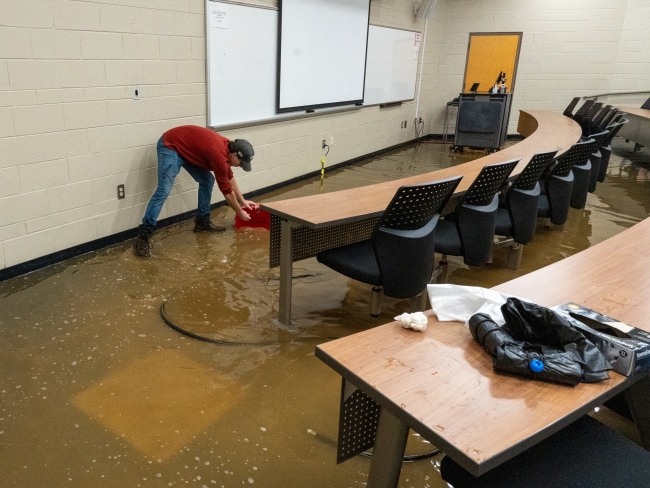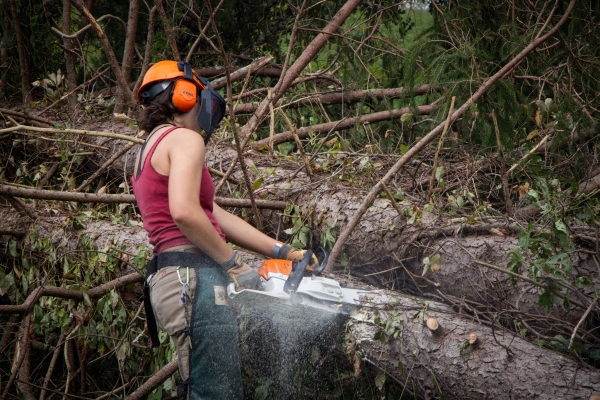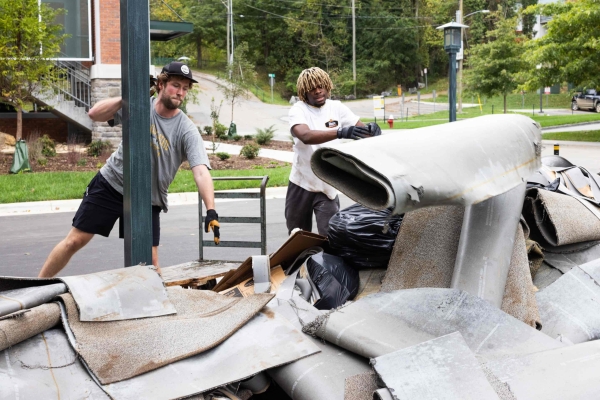You have /5 articles left.
Sign up for a free account or log in.

A volunteer helps remove floodwater from a classroom at Appalachian State University.
Appalachian State University
As colleges and universities across the western Carolinas start the cleanup from Hurricane Helene, administrators say a full recovery will take not just days or weeks, but months and possibly even years. Still, they remain confident that their institutions will be able to provide the required number of instruction hours, meet accreditation standards and complete the term.
“After any disaster, some of the most trying moments come when shock turns to exhaustion, and the outside attention seems to fade,” University of North Carolina system president Peter Hans told Inside Higher Ed. “But every campus plans to resume instruction as soon as the basic infrastructure is restored … The bottom line is we will resume classes and finish the semester.”
Photos and videos from campus communications teams and local journalists show lecture halls filled with water instead of students; fallen trees and power lines block many campus entryways. Most institutions, however, have reported minimal structural damage, saying that though campus centers may need new carpets and furniture, their buildings’ infrastructure remains sound.

A student at Warren Wilson College cuts a fallen tree to help clear campus access roads.
Warren Wilson College
The bigger challenge, they say, will be to restore utilities and help faculty and staff members who have lost homes or still lack access to basic needs. Among the state’s public institutions, Western Carolina and Appalachian State Universities, both of which have regained power and water, intend to be up and running by the middle of the month, according to recent announcements. But the University of North Carolina at Asheville announced last week that classes will remain canceled until at least Oct. 28.
Asheville, a city of 94,000—known for its bohemian arts scene, historic architecture and bustling breweries—still lacked running water a week after the storm. Helene destroyed several main lines of supply at the North Fork Water Treatment Plant, and inaccessible roadways have made it challenging for construction workers to make repairs. Electricity and the internet are also still down, according to The Citizen-Times.
“The water system is beyond our control,” Hans explained. “We’ve received encouraging assurance that it’ll be back up within a few weeks, but we can’t rely on that solely. So we’re making plans to meet the academic needs of students. Remote instruction certainly is one option.”
He added that though it is too early to put a dollar figure on the damage, the state has a “healthy rainy day reserve fund” that has generally benefited public universities when hurricanes have hit in the past.
Tapping into those funds, however, will take time. First the system has to determine what is reimbursable by grants from the Federal Emergency Management Agency. Only then, based on the gap between those funds and remaining expenses, will the system be able to request funds from the state.
In the meantime, John Dougherty, chief of staff and general counsel at UNC Asheville, said regaining access to utilities is the top “operational and safety necessity.”
“Communication with our campus and the broader community has been extremely limited due to impaired communications infrastructure,” he said. “But slowly, we are gradually regaining our ability to connect.”
Uplifted Despite ‘Devastation’
At least seven private institutions in North Carolina have also been impacted. Bordered by several miles of the Swannanoa River, Warren Wilson College, a small liberal arts institution just 20 minutes east of UNC Asheville, was among the most heavily flooded institutions in the state.
But unlike at some institutions, nearly all of Warren Wilson’s 725 students were on campus when the storm hit. And President Damián J. Fernández said their presence in the immediate aftermath was a huge asset to the emergency response.
As one of 10 federally designated work colleges, Warren Wilson requires all students to participate in a learning-service program and have a job on campus to help lower their tuition and fees. The program, Fernández said, inspires a resilient, all-hands-on-deck attitude that was key to mitigating immediate damage and restoring basic campus functions.
The president described how Phineas, a sophomore, got the campus kitchen up and running when road blockages prevented full-time food service workers from making it to campus, feeding his 700-plus peers that night. Sof, a senior, led the farm crew in rescuing university pigs that had been washed away from the farm and stranded in remote areas of the 1,100-acre campus and beyond. Others, he added, tapped two wells to provide fresh water and are managing sewage and sanitation.

A student on the Warren Wilson College farm crew tends to swine on the campus farm. Many animals were swept away and had to be tracked down once the storm ended.
Warren Wilson College
“This is really a story about learning in action and how our students are equipped to solve real-world problems,” Fernández said. “It has been uplifting despite the devastation.”
Still, like UNC Asheville, the campus remains without power or water. Once roads were deemed safe, college officials allowed students to begin voluntarily evacuating; now only 65 students remain. Classes will not resume until Oct. 21 and even then they may be remote, officials announced Friday.
But even as essential personnel evaluate and assess the state of campus, Fernández described the situation as a chance to start anew.
“We’re using this moment to think strategically. We’re not going to go back to the way things were,” he said. “This is an opportunity for thought leadership around, what does the campus, the farm, the work program look like? … How do we serve our community better?”
Hope Williams, president of the North Carolina Independent Colleges and Universities group, said for her and the administrators she works with, locating all faculty and staff and ensuring they are safe remain the top priorities.
“Not everyone has been found yet,” she said. “The question is whether it is simply the fact that they cannot communicate because cell service or internet or landlines are not working at the moment, or whether someone’s been hurt, or, we sadly have lost a number of North Carolina residents to the storm.”
‘Stretched to the Maximum’
Heather H. Norris, interim chancellor at Appalachian State, said her institution has been “fortunate,” in that they had “no actively missing students, faculty or staff.”
The largest task now is supporting the “deeply devastated community” that surrounds campus, since “town and county resources [are] stretched to the maximum.” The campus convocation center has been opened as a Red Cross shelter, and the central dining hall has already served more than 50,000 meals to anyone in need.
“There’s not a single person in this area that hasn’t felt the impact of this storm,” she said. “We’ve been putting essential personnel up in area hotels, as many can’t get home or don’t have homes to return to … Some of our students, faculty and staff have lost everything.”

Students at Appalachian State help remove and dispose of carpets ruined by the flood.
Appalachian State University
In the meantime, faculty members, like Andrew Koricich, are preparing to rework their semester plans in the hopes of alleviating stress for students and colleagues whose worlds were flipped upside down in a matter of hours.
For Koricich that means focusing on content delivery and learning engagement rather than assignment details in order to “respect the humanity of everyone involved.” But even with years of experience adapting to unprecedented events, he is figuring things out as he goes.
“To be honest, I’ve had to revise courses midway before due to unexpected events, but I’m still at a loss for how to revise a class when the impacts will be felt in some students for months to come,” he said.
Still Salvaging
Damage was also widespread at institutions in western South Carolina, including Lander University, where a recently finished retention pond helped mitigate some flooding. But it was a close call; chief financial officer Joseph Greenthal said that by the time the torrential downpours stopped Sept. 28, the 65-foot-deep emergency pool was filled to the brim. He also credits the storm’s speed through Greenwood as a saving grace.
“It was pretty scary, but not nearly like North Carolina,” he said. “That’s where it really slowed down and the water was able to accumulate.”
He added that the key to recovery at Lander, which is set to reopen Oct. 10, is communication and delegation.
“A lot of times, people start to panic in situations like this, and you can really start seeing duplicated efforts or indecision,” Greenthal said. “We implemented the National Incident Command System … so the message is consistent, the resources are in place and everybody’s kind of working together instead of working over each other.”
He expects that progress will pick up more quickly by the day as faculty and staff, many of whom suffered significant damage to their own homes, begin to recover and can travel back to campus.
(This story has been updated to correct Heather Norris's remarks on Appalachian State.)




